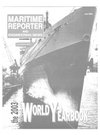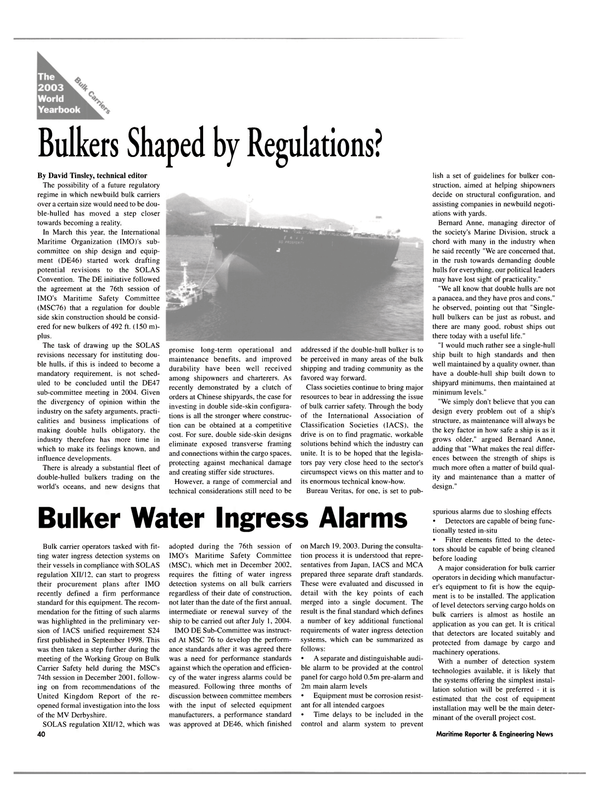
Bulker Water Ingress Alarms
Bulk carrier operators tasked with fitting water ingress detection systems on their vessels in compliance with SOLAS regulation XII/12. can start to progress their procurement plans after IMO recently defined a firm performance standard for this equipment. The recommendation for the fitting of such alarms was highlighted in the preliminary version of IACS unified requirement S24 first published in September 1998. This was then taken a step further during the meeting of the Working Group on Bulk Carrier Safety held during the MSC's 74th session in December 2001, following on from recommendations of the United Kingdom Report of the reopened formal investigation into the loss of the MV Derbyshire.
SOLAS regulation XII/12, which was 40 adopted during the 76th session of IMO's Maritime Safety Committee (MSC). which met in December 2002.
requires the fitting of water ingress detection systems on all bulk carriers regardless of their date of construction, not later than the date of the first annual, intermediate or renewal survey of the ship to be carried out after July 1, 2004.
IMO DE Sub-Committee was instructed At MSC 76 to develop the performance standards after it was agreed there was a need for performance standards against which the operation and efficiency of the water ingress alarms could be measured. Following three months of discussion between committee members with the input of selected equipment manufacturers, a performance standard was approved at DE46, which finished on March 19. 2003. During the consultation process it is understood that representatives from Japan, IACS and MCA prepared three separate draft standards.
These were evaluated and discussed in detail with the key points of each merged into a single document. The result is the final standard which defines a number of key additional functional requirements of water ingress detection systems, which can be summarized as follows: • A separate and distinguishable audible alarm to be provided at the control panel for cargo hold 0.5m pre-alarm and 2m main alarm levels • Equipment must be corrosion resistant for all intended cargoes • Time delays to be included in the control and alarm system to prevent spurious alarms due to sloshing effects • Detectors are capable of being functionally tested in-situ • Filter elements fitted to the detectors should be capable of being cleaned before loading A major consideration for bulk carrier operators in deciding which manufacturer's equipment to fit is how the equipment is to be installed. The application of level detectors serving cargo holds on bulk carriers is almost as hostile an application as you can get. It is critical that detectors are located suitably and protected from damage by cargo and machinery operations.
With a number of detection system technologies available, it is likely that the systems offering the simplest installation solution will be preferred - it is estimated that the cost of equipment installation may well be the main determinant of the overall project cost.
In consideration of the approach of the compliance schedule for SOLAS regulation XII/12 and the recent approval of the IMO performance standard, market interest for water ingress detection systems is growing rapidly. With literally thousands of vessels requiring the equipment, it is expected that manufacturers' delivery lead times will be extended as demand for equipment reaches its peak in the summer of 2004.
For operators who have vessels dry-docking prior to your latest fitting date of the first survey after July 1, 2004, then it may be greatly in their interests to consider installing the equipment during the scheduled dry-docking. Otherwise they may have to take the vessel out of service after the dry-docking to fit the equipment before/during the survey.
Arranging the installation of the equipment concurrently with general electrical/mechanical works during the dry-docking will undoubtedly deliver cost savings, and save a lot of time compared with arranging additional contractors during survey periods. It will also insure against the risk of costly delays to the sailing of the vessel, should the installation be delayed during the survey period.
Furthermore, for vessels that are offered for charter (if applicable). Charterers may favorably consider vessels equipped with water ingress alarm over those not similarly equipped.
Martek Marine' s BuIkSafe In full compliance with all aspects of the new IMO performance standard, Martek Marine Ltd.
offers its BULKSAFE water ingress detection system. Martek Marine Ltd. Managing Director Paul B. Luen said, "We were delighted to be afforded the opportunity of liasing with IMO DE sub-committee members over the development of the performance standard for water ingress level detection systems.
Three years in development, Luen says that BULKSAFE is "a unique offering and installation solution, which allows our MMS900 (patent pending) water level detectors to be installed so that they are totally isolated from the cargo and protected from dust and mechanical damage from cargo operations. Our BULKSAFETM system can be installed without any structural alterations or piping work within the cargo holds and can be commissioned by ship staff."
Read Bulker Water Ingress Alarms in Pdf, Flash or Html5 edition of June 2003 Maritime Reporter
Other stories from June 2003 issue
Content
- SS Norway Boiler Room Explosion Claims Seven Lives page: 3
- 95th Anniversary of the Burning of General Slocum page: 8
- Color Line Builds IT Environment With SIS page: 12
- BASS Provides New CrewNet Version page: 12
- Inmarsat Launch New Fleet Services page: 16
- Northrop Grumman Completes Builder's Trials on USS Ronald Reagan page: 17
- AIS - Panacea or Pandora's Box page: 18
- Government Update page: 20
- Seabulk Contracts for PSV in Brazil page: 22
- A.K. Suda Designed Crew/Supply Boat Carries More for Less page: 24
- Seminar Series Aims to Ensure Compliance page: 26
- NOAA Ship Whiting Decommissioned After 3 9 Years Of Service page: 29
- Enter the LNG-Fueled Supply Ship page: 30
- Triple Delivery for FBM Babcock Marine page: 31
- Innovative Propulsion System for Ferry page: 32
- America's Super Liner to Set Sail Once Again? page: 34
- Bulker Water Ingress Alarms page: 40
- Bulkers Shaped by Regulations? page: 40
- Prestige - A Charterer's Reaction page: 44
- U.S. Shipbuilding 2003: A Congested Attempt to Fund page: 48
- Littoral Combat Ship Leads the Charge page: 54
- New FSPV Vessel Unveiled page: 62
- SSS: Separate Storage Shuttling page: 62
- Tuna Farming Goes Offshore page: 64
- NOx Emissions from Merchant Ships page: 68
- Salvage Posture Changing With The Times page: 73
- A Step Forward For Thick Section Plate Cutting page: 77


